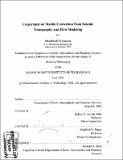Constraints on mantle convection from seismic tomography and flow modeling
Author(s)
Kárason, Hrafnkell, 1970-
DownloadFull printable version (29.66Mb)
Other Contributors
Massachusetts Institute of Technology. Dept. of Earth, Atmospheric, and Planetary Sciences.
Advisor
Robert D. van der Hilst.
Terms of use
Metadata
Show full item recordAbstract
In this thesis I combine high resolution seismic tomography and realistic flow modeling to constrain mantle convection. The bulk of the data used in the tomographic imaging are millions of P, pP and pwP travel time residuals, read from high frequency seismic records. The distribution of earthquakes and stations results in uneven data coverage and to improve the model I use core phases (PKP, Pdiff) for the deep mantle and surface reflected phases (PP) for the shallow mantle. Since narrow rays are not adequate for low frequency measurements, I construct broad 3-D sensitivity kernels to relate some of the added data to earth's structure. Furthermore, the parameterization of the tomographic model is adapted to data density and the model shows, among other details, the varying style of subduction in the shallow mantle and complex flow patterns around the transition zone between the upper and lower mantle. I develop a novel and efficient method of modeling buoyancy driven mantle flow in spherical geometry. Here, the linear Stokes equation is solved using a Green's function approach and 3-D surfaces, representing the boundaries of dense material, such as subducting slabs, are tracked through time.
Description
Thesis (Ph. D.)--Massachusetts Institute of Technology, Dept. of Earth, Atmospheric, and Planetary Sciences, 2002. Includes bibliographical references (p. 205-224).
Date issued
2002Department
Massachusetts Institute of Technology. Department of Earth, Atmospheric, and Planetary SciencesPublisher
Massachusetts Institute of Technology
Keywords
Earth, Atmospheric, and Planetary Sciences.